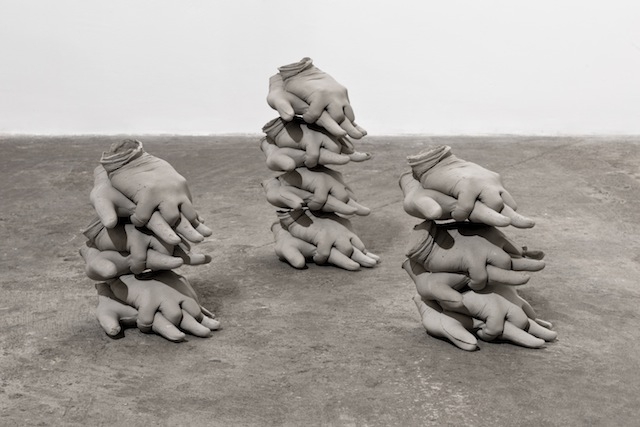The Ryder Projects, London, 9 March – 15 April
‘I can’t breathe.’ Those were the last words of Eric Garner, who died on Staten Island in 2014. Several police officers had confronted him about the alleged illegal sale of ‘loosies’ (single cigarettes). When he refused to be handcuffed, they put him in a chokehold – a form of restraint prohibited by NYPD regulations – and forced him on his knees before pushing him facedown to the ground. He fell unconscious on the sidewalk as officers looked on; they made no attempt to resuscitate him.
In satis three piles of cast-concrete gloved hands stand on the floor. Titled Minimum, Necessary, Objectively Reasonable #1 (2015, one of four works from the series in this exhibition) and stacked three and four high, each pair of hands is cast in the position required to perform a CPR-style chest compression. Creases between the fingers of the flesh-stretched material and the faint outline of a knuckle are the only traces of a hand that might have filled the glove cavity. But these hands are heavy and static; their material density suggests an oppressive, perhaps suffocating intent. The work’s title is evolved from terms used in US police guidance regarding the appropriate use of force.
Either side of the concrete hands, two works, Minimum… #4 (2015–16) and Minimum… #5 (2016), are placed diagonally opposite one another: the first features coiled latex tubing attached to a glass rod and sits on a table; the second is a metal-framed medical screen made up of three hinged latex panels. When stretched out, the rubber tube – soft, and the nauseating colour of raw pork – would be 6m, roughly the length of a human’s small intestines. Indeed, it resembles equipment used for colonic irrigation, the fleshy tone adding to this distinctly invasive subtext.
There’s something disquieting about the small white brickwalled space in which this series and two other works are shown. It’s as if one has accidentally stumbled into an ‘enhanced interrogation’ room – the surrounding works look for use in such activities; whether intentional or not, the effect brings about an instinctive need to back out of the room.
A disembodied male voice vibrates through the space, repeating a single Latin word – the title of the show – at long intervals. On the back wall, a photograph (Fetor. Greetings, 2014) showing a scene of civil unrest and composed of collaged images hangs as a clue to piecing together the exhibition.
2014 marked a breaking point in trust between state police and civilians in the US. Wide media coverage of police brutality – especially against ethnic minorities – increased public awareness of instances in which the abuse of power led to fatalities. At the end of 2015, a study found that ethnic minorities made up more than half of the total unarmed people killed by police that year. In light of this, the exhibition (and particularly Minimum… #1, where the concrete hands are more likely to crush, rather than restart a heart) raises questions about what happens when an institution set up to safeguard becomes a threat.
Anomalia (2015), a portmanteau of ‘anomaly’ and ‘animalia’, is a sculpture of a crouching black puffer jacket with its arms rooted to the ground, calling to mind someone who has been brought to their knees. Axelrad appears to position this item of clothing, which is synonymous with ‘street wear’, as a comment on the way police officers use profiling – a judgement based on someone’s appearance – when suspecting a person of committing a crime. Here, the jacket, in a similar way to the concrete hands, reflects the absence of a human – and in its hunched stance, it is ambiguously agonistic. The dehumanisation of the ‘anomaly’ runs throughout history, rendering those targeted as other to ‘normative society’, therefore making it easier to justify elimination; at the same time, the act of committing violence calls into question the humanity of the perpetrator. But there’s also a resistance in Anomalia – the puffer jacket, frozen in position, refuses the floor.
Long after leaving, the voice that accompanied the exhibition echoes inside the ear, a strained wheezing of the word satis: ‘enough’.
First published in the May 2017 issue of ArtReview
